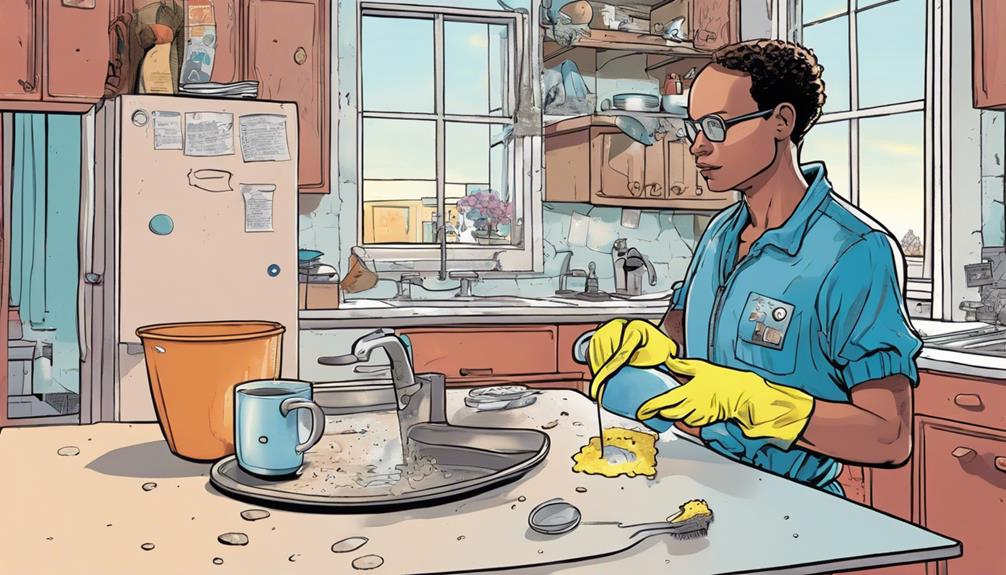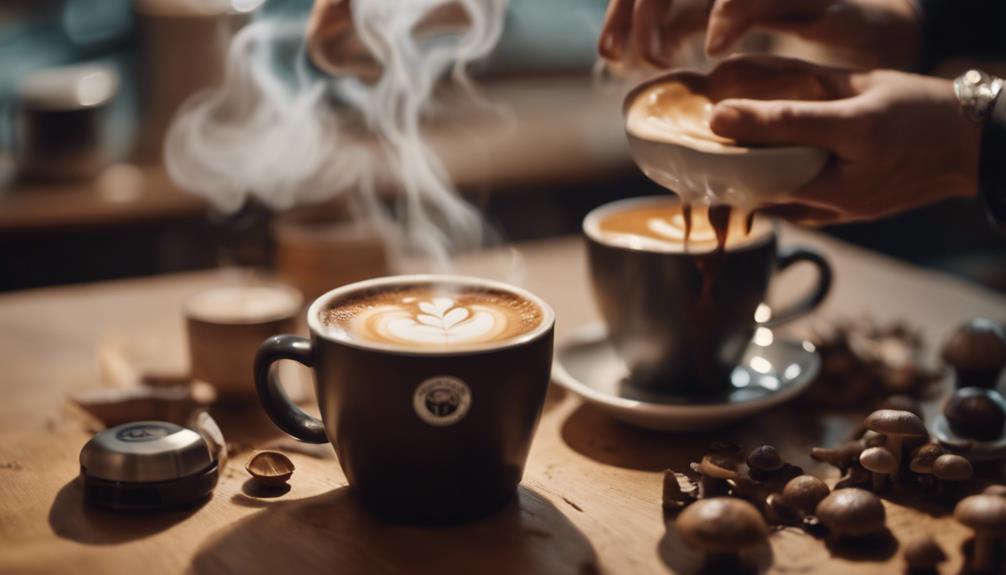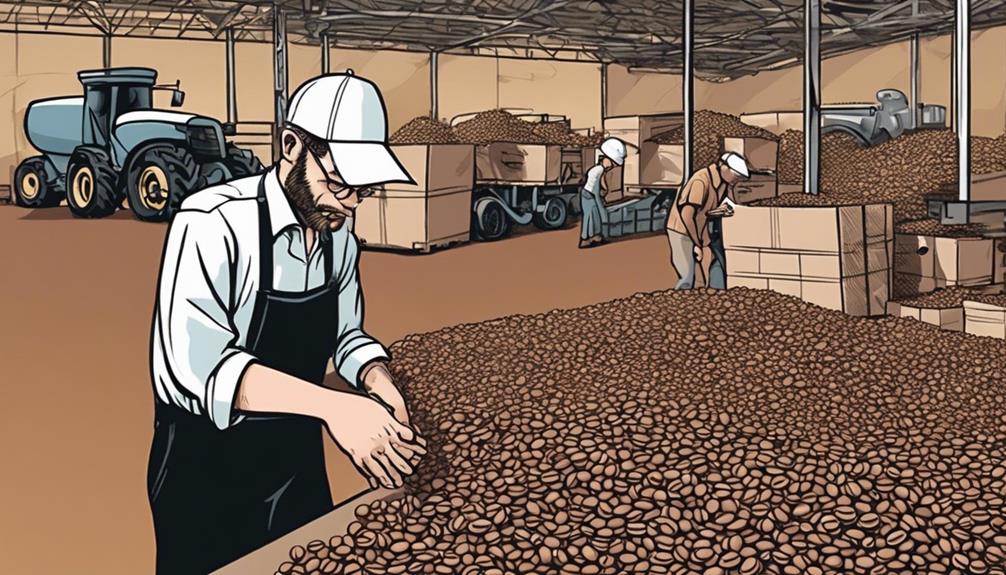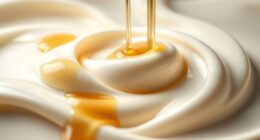To safely bleach coffee cups, mix 1 part bleach with 4 parts water. Soak cups for 30 minutes, wear gloves, rinse, then air dry. Following these steps ensures thorough cleaning while prioritizing safety.
Key Takeaways
- Dilute bleach with water (1:4 ratio).
- Soak cups for 30 minutes.
- Rinse thoroughly after soaking.
- Work in a well-ventilated area.
- Wear gloves for skin protection.
Testing Coffee Stain Cleaning Methods
Five different methods for cleaning coffee stains inside mugs were tested and rated based on ease and efficiency in New York City. The evaluation aimed to find the most effective method for removing stubborn coffee stains. Among the methods tested were the white vinegar, denture tablet, lemon wedge, Bar Keepers Friend, and baking soda cleaning techniques.
The first method tested was the hot water and white vinegar combination. It was rated as a decent option for light stains but struggled with more stubborn marks. However, when used as the 'First Thing' in the morning, it provided an invigorating start to the day.
The hot water method was found to be efficient when combined with other cleaning agents like Bar Keepers Friend or baking soda. This combination proved to be a powerful stain-fighting duo for those tough-to-remove coffee marks, especially in mugs that had been neglected for some time.
White Vinegar Method Overview
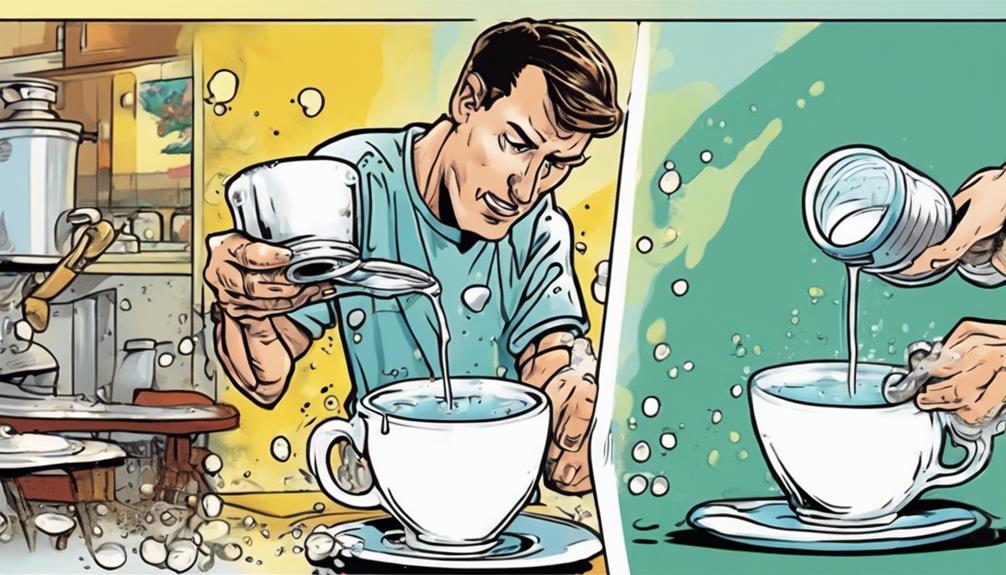
You'll learn about the benefits of using vinegar,
get practical tips on applying it effectively,
and understand the safety precautions to keep in mind.
Vinegar Benefits Explained
Utilizing white vinegar as a mild acid, the method for cleaning coffee cups involves filling the mug with boiling water and vinegar. White vinegar is effective in breaking down coffee stains due to its acidic nature. Here are some benefits of using white vinegar in cleaning coffee cups:
| Vinegar Benefits | Explanation |
|---|---|
| Mild Acid | Helps break down stubborn coffee stains. |
| Natural Disinfectant | Kills bacteria and germs present in the mug. |
| Odor Neutralizer | Removes any lingering coffee smells. |
| Eco-Friendly | A non-toxic and environmentally safe option. |
| Cost-Effective | Affordable and readily available in stores. |
While white vinegar is not as potent as some other cleaning methods, it is still a useful and gentle option for regular coffee cup maintenance. Remember, although white vinegar can help loosen stains, it might require additional scrubbing and thorough cleaning for deeply embedded marks.
Application Tips Shared
To effectively apply the White Vinegar method for cleaning coffee cups, start by filling the mug with boiling water and white vinegar. The mixture should be left to soak for a few minutes, allowing the solution to work on loosening the stains.
After soaking, scrub the mug thoroughly with a sponge or brush to remove any remaining residue. While this method may not be the quickest, requiring about 8 minutes in total with 3 minutes of active cleaning, it can still be effective for surface-level stains when used with some elbow grease.
Keep in mind that White Vinegar isn't the best option for deep coffee stains, as it received a low rating for ease and efficiency. However, for regular maintenance and light stains, this method can be a budget-friendly and eco-friendly alternative to harsher chemicals.
Safety Precautions Highlighted
When using the white vinegar method to clean coffee cups, be mindful of safety precautions to ensure effective and safe bleaching. Here are some essential safety tips to keep in mind:
- Ventilation is Key: Guarantee proper airflow when working with white vinegar to prevent inhaling strong fumes.
- Protect Your Skin: Wear gloves to safeguard your hands from potential irritation caused by the vinegar solution.
- Avoid Mixing Chemicals: Never mix white vinegar with other cleaning agents, as it can create harmful reactions.
While the white vinegar method is commonly used for cleaning, it may not be the most effective solution for stubborn coffee stains. Considering alternative methods like baking soda can provide better results without compromising safety.
Denture Tablet Method Procedure
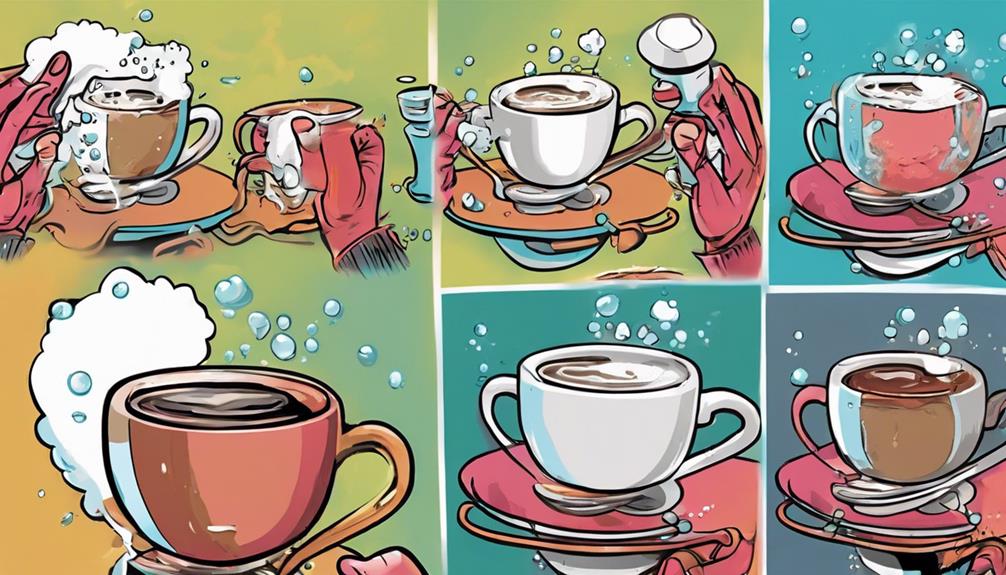
You activate the Denture Tablet by dissolving it in warm water, creating a bubbling solution that helps lift stains from your coffee cups.
The efficiency of this method in removing tough stains is rated at 1.5 out of 5, requiring some scrubbing to achieve best results.
Denture Tablet Activation
Activate the denture tablet by dropping it into warm water inside the stained coffee mug. As the tablet fizzes and bubbles, it starts working to loosen those stubborn coffee stains. Let it sit for around 15 minutes to allow the cleaning power to work its magic.
Here are some tips to keep in mind during the denture tablet activation process:
- Watch in amazement as the tablet transforms the water into a potent cleaning solution.
- Enjoy the satisfying sound of the fizz as the tablet breaks down the coffee stains.
- Take a moment to appreciate the simplicity of this effective cleaning hack.
Once the tablet has had time to work its magic, gently scrub the mug with a sponge or brush to remove the loosened stains. Finish off by rinsing the mug thoroughly to make sure all remnants of the denture tablet and coffee stains are completely gone.
Stain Removal Efficiency
The denture tablet method for cleaning coffee cup stains demonstrates moderate efficiency in removing tough coffee stains. While it involves a bubbling process that can be visually appealing, the actual removal of stains requires some elbow grease. During testing, this method was rated 1.5 out of 5 for its stain removal effectiveness. It took a total of 20 minutes to complete, with 5 minutes dedicated to active cleaning.
Here's a breakdown of the denture tablet method procedure:
| Aspect | Details | Efficiency Rating |
|---|---|---|
| Time Taken | 20 minutes total, 5 minutes of active cleaning | – |
| Cleaning Process | Requires scrubbing after the bubbling action | 1.5/5 |
| Visual Appeal | Bubbling process can be entertaining to watch | – |
| Residual Stains | Potential for some stains to remain | – |
Lemon Wedge Method Step-by-Step

To effectively employ the lemon wedge method for bleaching coffee cups, rub a newly-cut lemon wedge inside the stained mug for approximately 1-2 minutes. Make certain the lemon juice covers all stained areas inside the mug, and then rinse the mug thoroughly with water.
You'll enjoy the invigorating lemon scent left behind in the mug post-cleaning.
- Rub a newly-cut lemon wedge inside the stained coffee mug for approximately 1-2 minutes.
- Ensure the lemon juice covers all stained areas inside the mug.
- Rinse the mug thoroughly with water after using the lemon wedge.
This method is a natural and revitalizing way to tackle light stains on your coffee cups. While it may not completely eliminate tough stains, it's a great initial step in the cleaning process.
Plus, the citrusy aroma will leave your mug smelling delightful after cleaning. Give this simple and eco-friendly technique a try for a quick cup refresh!
Bar Keepers Friend & Steel Wool
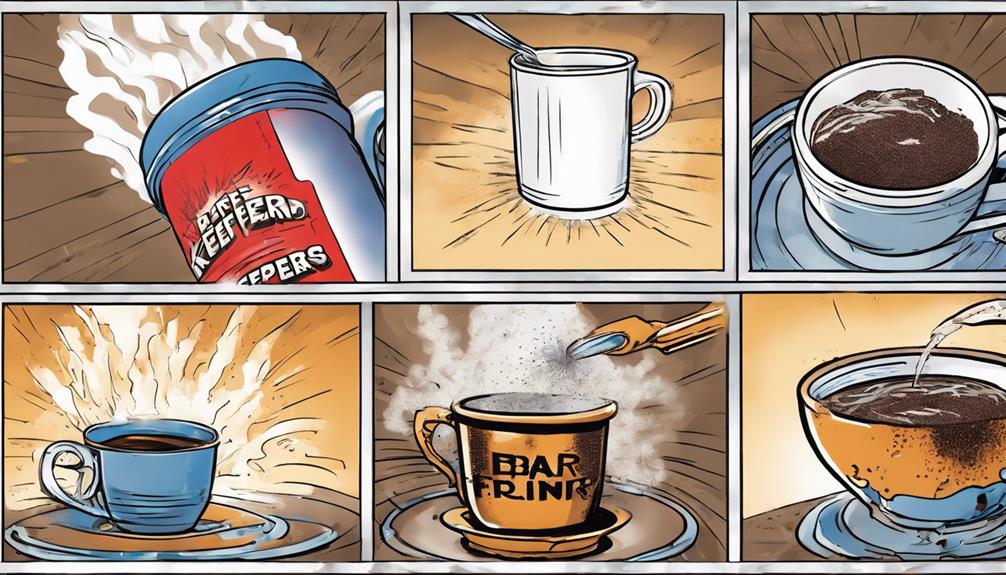
When tackling tough coffee stains in your mugs, consider using Bar Keepers Friend powder with a steel wool pad for effective removal.
Remember to handle the steel wool pad with care to avoid damaging the mug's surface during scrubbing.
This method combines efficiency, safety, and powerful cleaning for your coffee cups.
Effectiveness of Method
For best results in bleaching coffee cups safely, consider the effectiveness of using Bar Keepers Friend and a steel wool pad. This dynamic duo received a solid 4 out of 5 rating for its ability to tackle tough coffee stains inside mugs.
The process only required 11 minutes to complete, with just 1 minute of active scrubbing needed. However, it's essential to be cautious not to scrub too vigorously with the steel wool pad to prevent potential damage to the mug.
The combination of Bar Keepers Friend powder and the abrasive steel wool pad proved to be highly effective in removing stubborn coffee stains, making it a go-to method for cleaning your favorite mugs.
Safety Considerations
Exercise caution when using Bar Keepers Friend and steel wool pads for cleaning coffee mugs, as both products have specific safety considerations to keep in mind. Bar Keepers Friend, while generally safe for most surfaces, contains oxalic acid, which can be harmful if ingested in large amounts. It's important to wear gloves when handling this cleaner to protect your skin from potential irritation.
Steel wool pads, on the other hand, are abrasive and can scratch or damage delicate mug surfaces. Be mindful when using them to avoid causing any harm.
After cleaning with Bar Keepers Friend, make sure thorough rinsing of the coffee mugs to eliminate any residue that could affect the taste of your next beverage. Additionally, store both the cleaner and steel wool pads out of reach of children and pets to prevent accidental ingestion or misuse.
Cleaning Tips for Mugs
To effectively clean your coffee mugs using Bar Keepers Friend and a steel wool pad, follow these tips for safe and efficient stain removal. When dealing with tough coffee stains, this method can be a game-changer in restoring your mugs to their former glory.
Here are some key tips to keep in mind:
- Apply a small amount of Bar Keepers Friend powder to the stained areas on the mug.
- Gently scrub the stained areas with a dampened steel wool pad in a circular motion.
- Rinse the mug thoroughly with water after cleaning to remove any remaining residue.
Baking Soda Cleaning Technique
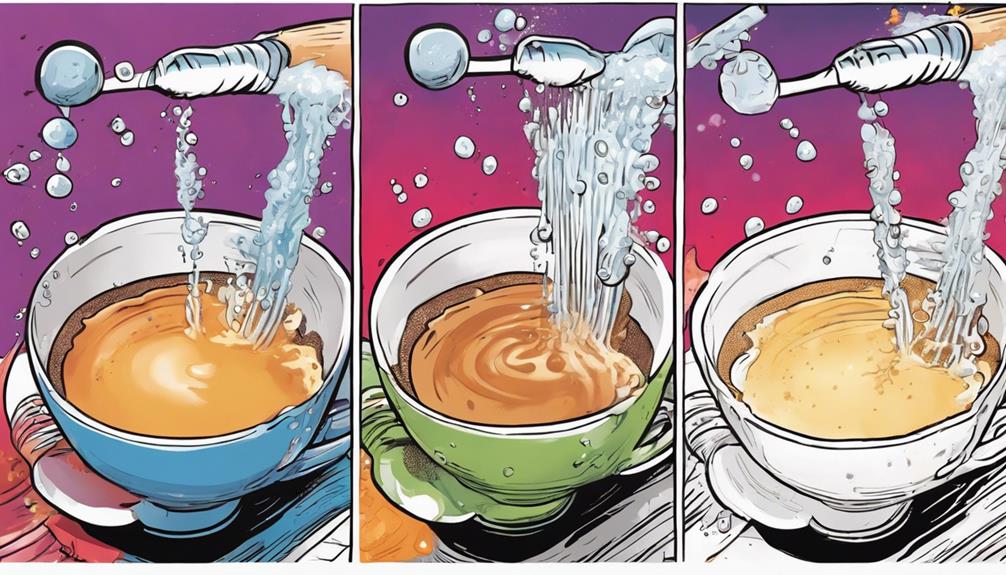
Consider using a mixture of baking soda and water to effectively clean tough coffee stains inside your mugs. Baking soda is a highly effective and safe cleaning agent for this purpose. By creating a paste with baking soda and water, you can easily scrub and clean the stains without causing any damage to the mug.
The gritty nature of the baking soda paste aids in scrubbing away stubborn stains while remaining gentle on the mug's surface. This cleaning method has been rated 5 out of 5 for its efficiency and lack of residual odors or flavors.
In just 3 minutes, with only 1 minute of active cleaning, you can have your coffee cups looking as good as new. So, next time you're faced with tough coffee stains in your mugs, reach for baking soda and water for a quick and effective cleaning solution.
Method Ratings and Findings
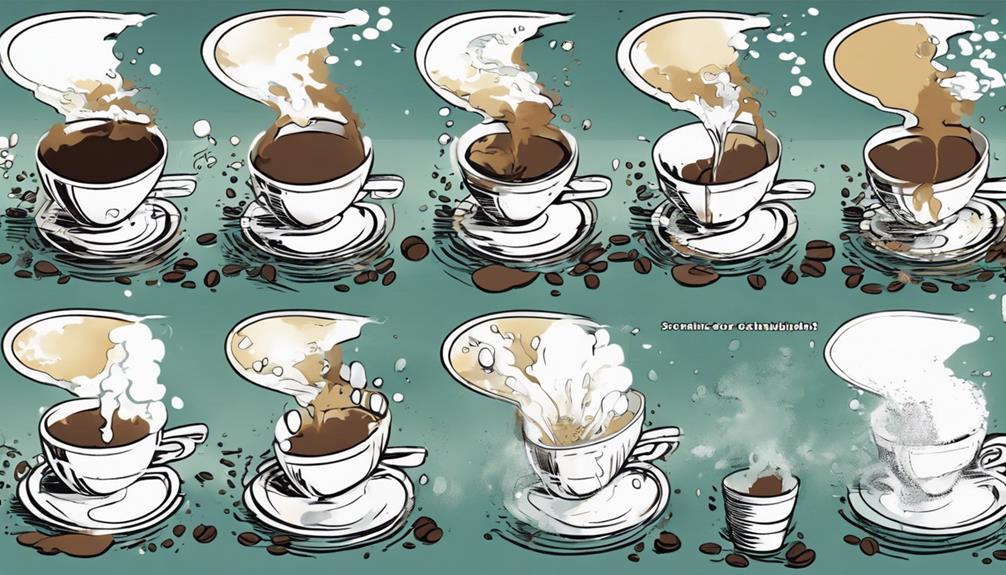
For the most effective method in bleaching coffee cups safely, the ratings and findings indicate that using a paste made of baking soda and water received the highest score of 5 out of 5 for its efficiency and ease of use.
Here are some key findings to take into account:
- Bar Keepers Friend and Steel Wool Pad were also highly effective, rated 4 out of 5 for their ability to remove tough stains with minimal effort.
- White vinegar and denture tablets scored 1 and 1.5 out of 5, respectively, requiring more scrubbing and time for stain removal.
- Utilizing a lemon wedge inside the mug got a rating of 2 out of 5, leaving a pleasant smell but needing thorough washing afterward and not being highly effective.
The overall conclusion from these findings is that a baking soda paste stands out as the safest and most efficient method for effectively bleaching coffee cups.
Best Way to Bleach Cups
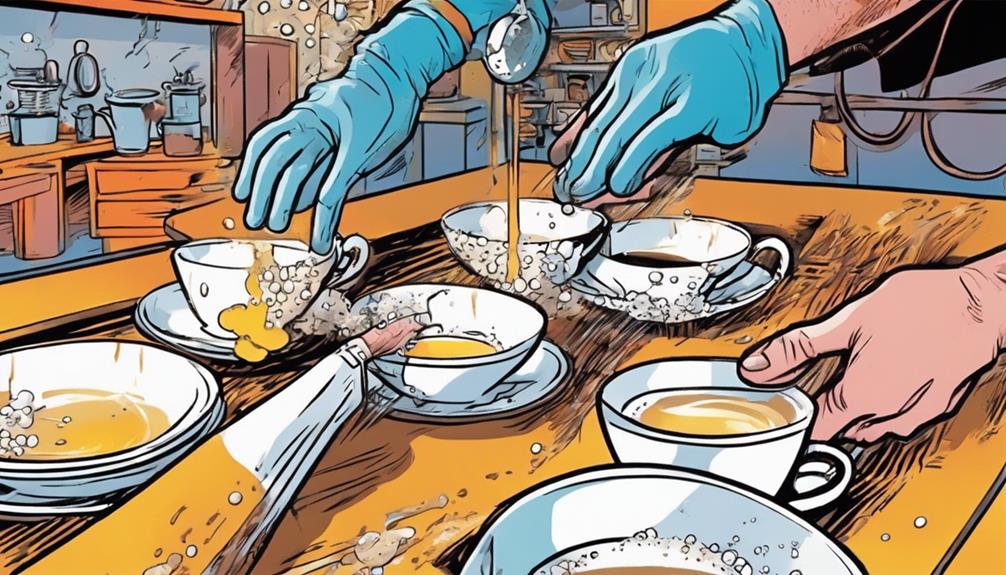
Begin by combining a solution of 1 part bleach to 4 parts water in a well-ventilated area to safely whiten your coffee cups.
Submerge the stained coffee cups in the bleach solution for at least 30 minutes to effectively eliminate tough stains.
Remember to wear gloves and avoid any contact with your skin or eyes when handling bleach to prevent irritation or harm.
After soaking, make sure to thoroughly rinse the cups with water to remove any bleach residue before using them again.
It's important to allow the cups to air dry completely before storing or using them to make sure no residual bleach remains.
Efficient Coffee Cup Cleaning

To efficiently clean your coffee cups, consider using Bar Keepers Friend or baking soda for a quick and effective removal of tough stains. These cleaning agents have been rated highly for their effectiveness in eliminating coffee stains from mugs with minimal effort.
Here are three key points to keep in mind:
- Bar Keepers Friend and a steel wool pad received a rating of 4 out of 5 for their efficient stain removal capabilities.
- Baking soda, rated 5 out of 5, is highly effective in cleaning coffee stains inside mugs without leaving any unwanted odors or flavors.
- White vinegar and denture tablets were found to be less efficient, receiving ratings of 1 and 1.5 out of 5, respectively, as they required more effort and scrubbing to remove coffee stains.
Safe Mug Bleaching Tips
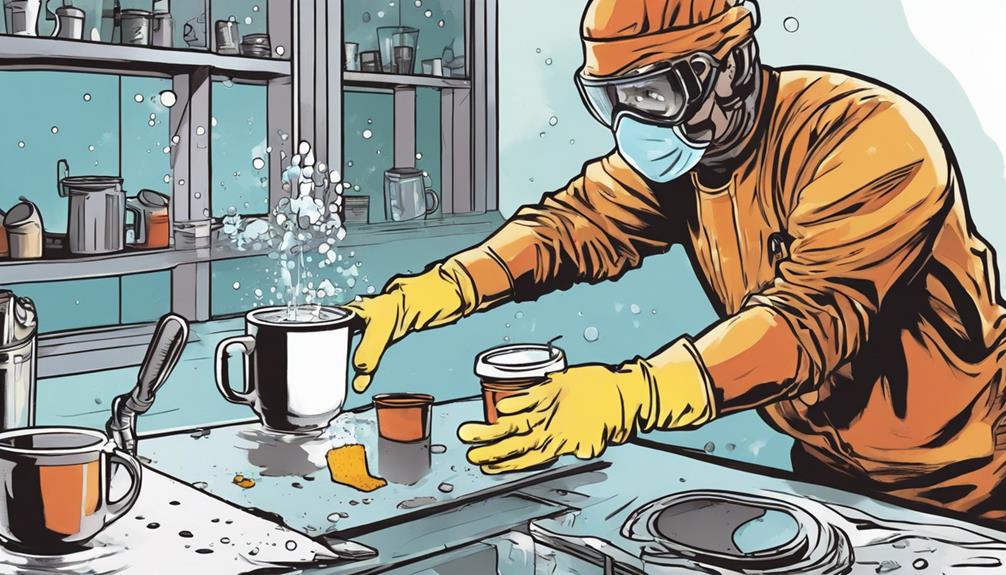
Considering safety when bleaching your coffee cups, how can you effectively sanitize and remove stains without causing harm? When bleaching your coffee cups, it is important to use a diluted bleach solution and avoid contact with your skin or eyes. Wear protective gloves and ventilate the area while working with bleach. To effectively sanitize and remove stains from your coffee mugs, mix one tablespoon of bleach with one quart of water and let the cups soak for at least one minute. Then, rinse thoroughly with water and allow to air dry. If you are unsure of how to bleach coffee mugs safely, it is best to consult the manufacturer’s recommendations or seek advice from a professional.
Start by creating a diluted bleach solution with 1 tablespoon of bleach per gallon of water. This concentration is effective for sanitizing and removing stains without damaging your mug. Remember to work in a well-ventilated area to prevent inhaling bleach fumes.
When applying the bleach solution to the cup, let it sit for at least 2 minutes to guarantee thorough sanitization. After the designated time, rinse the mug thoroughly with water to eliminate any remaining bleach residue.
Additionally, always wear gloves to protect your skin from potential irritation or burns when handling bleach. By following these safe mug bleaching tips, you can effectively clean and sanitize your coffee cups without compromising your health or the integrity of the mug.
Frequently Asked Questions
How Do You Bleach Cups Safely?
To bleach cups safely, start by thoroughly cleaning and rinsing them. Use a bleach solution of 1 tbsp of bleach per gallon of water. Soak cups for 2 minutes, then wash with dish soap. Remember to wear gloves and work in a well-ventilated area.
Is It Safe to Use Bleach to Clean Coffee Mugs?
Using bleach to clean coffee mugs can be safe if diluted properly. Remember to follow the recommended ratio and rinse thoroughly. Avoid using bleach on colored mugs to prevent damage. When used correctly, bleach can effectively remove tough stains.
How Do You Whiten Coffee Cups?
To whiten coffee cups, mix one part bleach with nine parts water. Soak cups in the solution for 15-30 mins. Rinse thoroughly. Avoid using pure bleach to prevent damage and wear gloves in a well-ventilated space.
How to Remove Black Marks From Coffee Cups?
To remove black marks from coffee cups, make a paste with baking soda and water or use Bar Keepers Friend powder with a steel wool pad. Both methods are effective and safe, rated highly for stain removal.
Conclusion
So there you have it, folks! With these cleaning hacks, your coffee cups will be sparkling like diamonds in no time.
Just imagine sipping on your morning brew from a cup so clean you can see your reflection in it.
Keep those mugs looking fresh and bright with these safe and efficient bleaching tips.
Cheers to a clean cup of coffee every morning!
